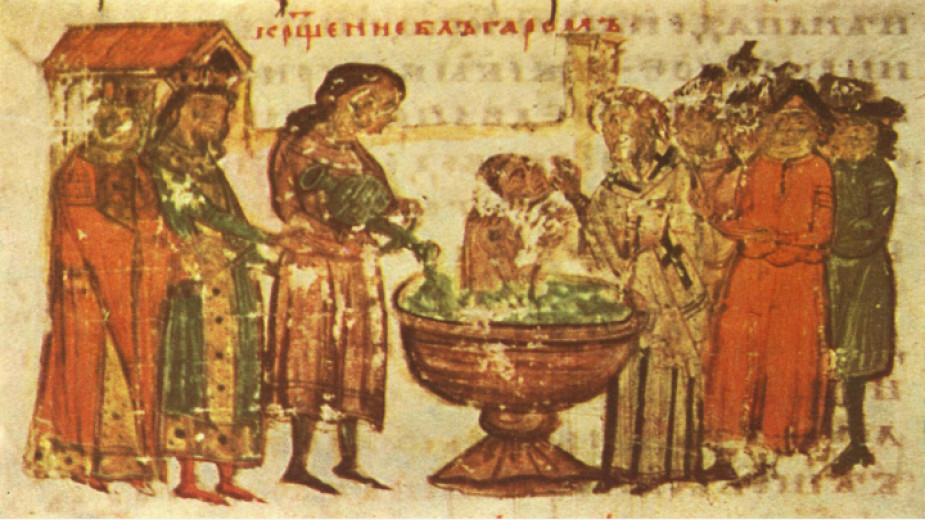
Knyaz Boris I Mihail is one of the most significant personalities of the First Bulgarian Kingdom (681-1018). His name is inextricably linked to the historical destiny of the Bulgarian people and the Bulgarian Orthodox Church, which canonized Knyaz BorisI Mihail as a saint and honors his memory on May 2.
Professor Petar Angelov from the Faculty of History of the Sofia University Saint Kliment Ohridski explains that Knyaz Boris I Mihail had to make three imortant decisions. He had to choose between paganism and christianity and he chose christianity. Secondly, he had to choose between Constantinpole and Rome. Although Rome tried to make him change his decision after 870, he ramained in the bossom of the Byzantine cultural and religious circle. He had to make a third decision as well – whether to leave Greek liturgy in Bulgaria, which became an official liturgy after the conversion to Christianity, or to allow the disciples of Cyril and Methodius to teach the Bulgarian clergy preach in their language. All these steps made by Knyaz Boris I Mihail during his rule between 852 and 889 guarantted rapid political and cultural upsurge of the Bulgarian Kingdom.
 Professor Angelov explains that Knyaz Boris I Mihail was a descendant of the Krum dynasty, son of Bulgarian Khan Presian, and adds that such type of information cannot be found easily in the historical sources, which are mainly foreign ones, because, Knyaz Boris Mihail was a different personality. That is why he is considered one of the greatest rulers in the Bulgarian hisory. Boris felt the necessity of adopting Christianity and became the first Bulgarian ruler who converted to Christianity under the name Mihail.
Professor Angelov explains that Knyaz Boris I Mihail was a descendant of the Krum dynasty, son of Bulgarian Khan Presian, and adds that such type of information cannot be found easily in the historical sources, which are mainly foreign ones, because, Knyaz Boris Mihail was a different personality. That is why he is considered one of the greatest rulers in the Bulgarian hisory. Boris felt the necessity of adopting Christianity and became the first Bulgarian ruler who converted to Christianity under the name Mihail.
This difficult decision was not taken at random by any means. Knyaz Boris realized that a large part of the population in some Bulgarian districts had already turned to Christianity, mainly in Macedonia which converted to this religion when it was still part of the Byzantine Empire. This reminds us of the time of Constantine the Great who was the first Roman Emperor to convert to Christianity and made the difficult decision to declare religious tolerance for Christians within the Roman Empire in 313, taking into consideration the fact that most of the population already converted to Christianity. That is why Boris is known as the New Constantine, because he adopted Christianity in Bulgaria in 864. Knyaz Boris Mihail showed vision for the changes that occurred in Bulgaria at that time and realized that it would be much easier to live together with the powerful Christian empire to the south if he converted to Christianity as well.
On March 4, 870, the Eight Ecumenical Council in Constantinople recognized the autocephaly of the Bulgarian Orthodox Church which became an autonomous archbishopric. The independence of the Bulgarian church is due to the diplomatic skills of Knyaz Boris Mihail, Professor Angelov contends. Boris followed the principle to use the controversy between the East and the West in general and between Constantinople and Rome in particular. The biggest contribution of Knyaz Boris Mihail to the culture field is linked with the popularization and the spread of the Slavonic script. The deed of the brothers Cyril and Methodius is associated with Great Moravia, because the script was created for the Slavs who lived in Great Moravia, not for the Bulgarians, who were still followers of paganism at that time.
If Bulgaria had not receive some of the students of Cyril and Methodius, who were chased away from Great Moravia, this great deed would have remained an interesting historical fact only, Professor Angelov continues. Knyaz Boris Mihail had huge contribution to this process, because he received in Bulgaria the disciples of Cyril and Methodiu – Naum, Kliment and Angelarius and allowed them to establish their own schools, educate the church clerics and declare the Old-Bulgarian language as an official language for religious services. The graphic system created by Cyril and Methodius is known as Glagolitic alphabet. We write in Cyrillic alphabet today. One of the hypotheses has it that this script was introduced by Clement of Ohrid (Kliment Ohridski). This graphic system is used for translation of religious books. Talking to people in a clear and comprehensible language is the best way to popularize and affirm Christianity. This is a contribution for most of the Slavonic world, because the literature created during the Golden Age of Bulgaria spread in other Eastern Orthodox countries such as Russia and Serbia.
English version: Kostadin Atanasov
Meatfare Sunday in 2025 will be remembered as a major celebration for the Bulgarian Orthodox Church and the entire Bulgarian community in the United Kingdom. The "St. John of Rila" Orthodox Church, built with funds from the Bulgarian state and with..
All Souls' Day (Zadushnitsa in Bulgarian) is an important day for many Christians. On this day, we remember deceased relatives and loved ones. The first of the three All Souls' Days of the year, also known as the Great or All Souls' Day, falls on the..
152 years after Bulgaria lost its beloved son and advocate for a free, independent and tolerant state – Vasil Levski, his personality continues to excite and inspire Bulgarians from all generations. Scholars continue to study the work of the Apostle..

+359 2 9336 661
